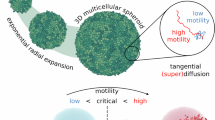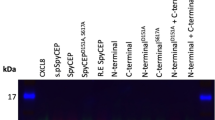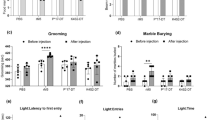Abstract
Two major areas in scrapie research depend on estimates of the concentration of the agent: investigation of the nature of the agent by the effect of various chemical or physical treatments and of the pathogenesis of the disease. Two methods have been used for these estimates. One is conventional serial dilution, with the end-point measured either by appearance of clinical disease1–6 or by the occurrence of the brain lesions at a chosen time after injection7. The second methed relies on the finding that the incubation period is very closely related to dose if other variables are constant8,9; when this relationship has been found for a given combination of strain of agent, tissue source, route and dose of injection and genotype of recipient, the concentration of agent can be estimated from the incubation period of a single dilution group.
This is a preview of subscription content, access via your institution
Access options
Subscribe to this journal
Receive 51 print issues and online access
$199.00 per year
only $3.90 per issue
Buy this article
- Purchase on SpringerLink
- Instant access to full article PDF
Prices may be subject to local taxes which are calculated during checkout
Similar content being viewed by others
References
Alper, T., Haig, D. A., and Clarke, M. C., Biochem. Biophys. Res. Commun., 22, 278 (1966).
Dickinson, A. G., and Meikle, V. M. H., Genet. Res., 13, 213 (1969).
Eklund, C. M., Kennedy, R. C., and Hadlow, W. J., in Proc. Scrapie Seminar, 288 (US Dept. Agric., Washington, 1964).
Gibbs, C. J., Current Topics in Microbiology and Immunology, 40 (Springer Verlag, Berlin, 1967).
Pattison, I. H., and Smith, K., Res. Vet. Sci., 4, 269 (1963).
Zlotnik, I., and Rennie, J. C., Brit. J. Exp. Path., 48, 171 (1967).
Mould, D. L., Dawson, A. McL., and Smith, W., J. Comp. Pathol., 77, 387 (1967).
Hunter, G. D., Millson, G. C., and Chandler, R. L., Res. Vet. Sci., 4, 543 (1963).
Dickinson, A. G., Meikle, V. M. H., and Fraser, H., J. Comp. Pathol., 79, 15 (1969).
Hunter, G. D., Gibbons, R. A., Kimberlin, R. H., and Millson, G. C., J. Comp. Pathol., 79, 101 (1969).
Dickinson, A. G., Meikle, V. M. H., and Fraser, H., J. Comp. Pathol., 78, 293 (1968).
Mims, C. A., Brit. J. Exp. Pathol., 41, 52 (1960).
Author information
Authors and Affiliations
Rights and permissions
About this article
Cite this article
DICKINSON, A., FRASER, H. Modification of the Pathogenesis of Scrapie in Mice by Treatment of the Agent. Nature 222, 892–893 (1969). https://doi.org/10.1038/222892a0
Received:
Issue date:
DOI: https://doi.org/10.1038/222892a0
This article is cited by
-
Letter to the Editor
Molecular Medicine (1999)
-
Decontamination studies with the agents of bovine spongiform encephalopathy and scrapie
Archives of Virology (1994)
-
Attempts to establish the scapie agent in cell lines
Veterinary Research Communications (1984)
-
Slow infections of the central nervous system
Zeitschrift f�r Neurologie (1971)
-
Pathogenesis of Scrapie in the Mouse: the Role of the Spleen
Nature (1970)



